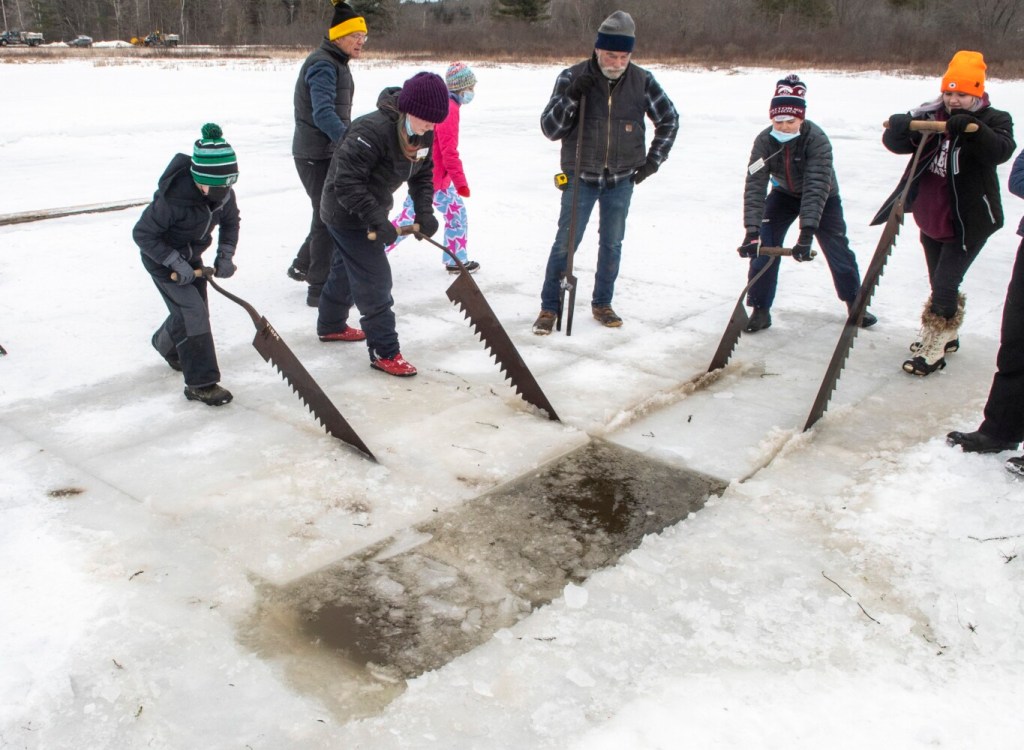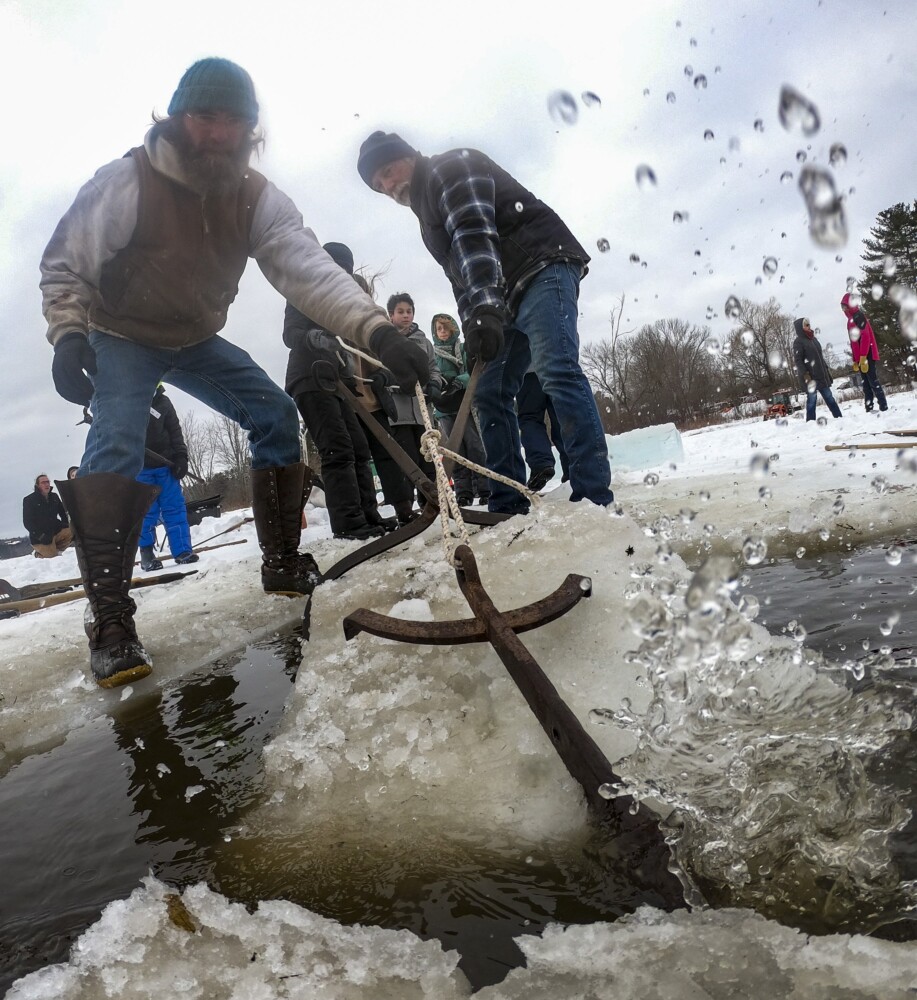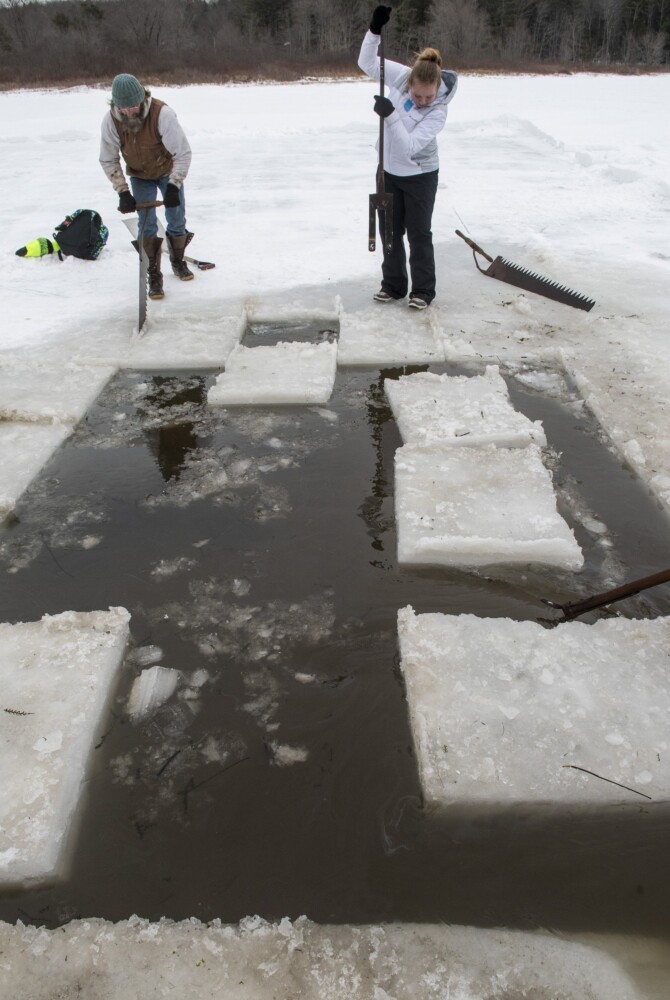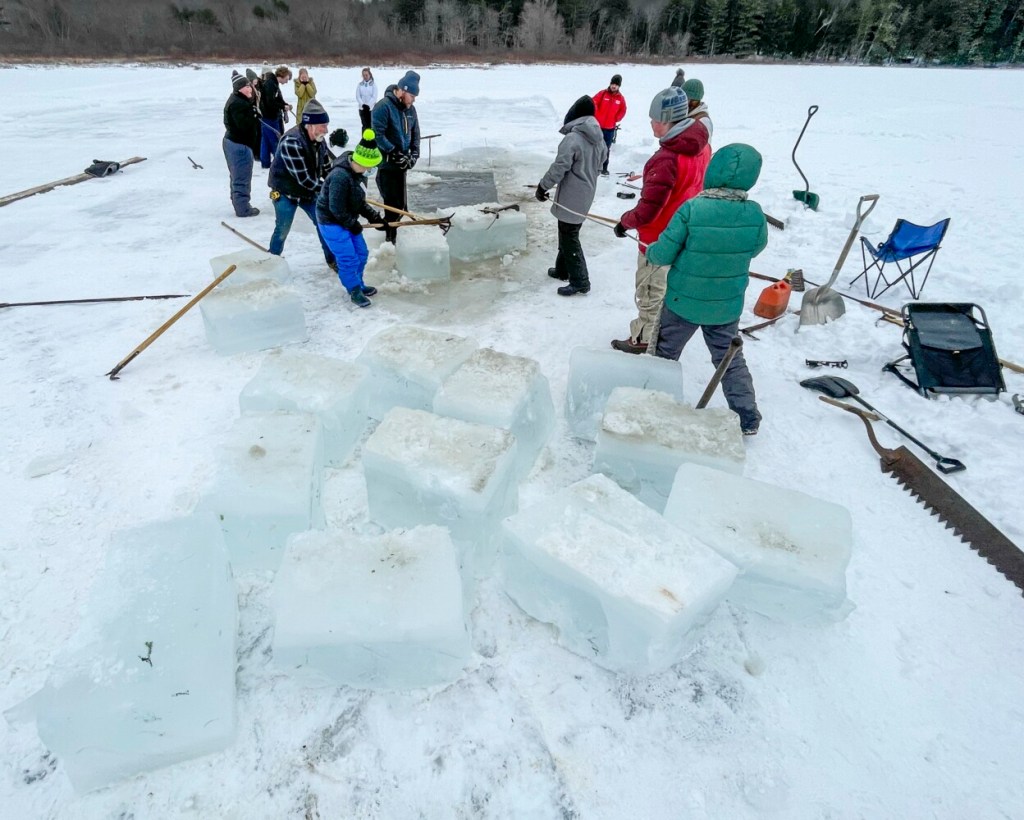READFIELD — Maranacook Community Middle School teacher Dan Holman has tried every year since becoming a teacher to host an ice harvest for his students. On Wednesday, he finally got the opportunity to do so.
The middle school students who are a part of the “Acadia team” bundled up in their winter boots, hats and mittens, and walked across the street to Readfield Beach where the activities took place. Not only would students participate in the ice harvest, but they would also be able to try snowshoes and ice fishing, see a fish dissection and hear presentations from University of Maine at Farmington students, the United States Geological Service and the Maine Game Wardens.
At the middle school, students have the opportunity to have a say in what they would like to learn. Last year, they chose civil rights and equality, but this year, through learning about Maine’s culture, a unit on ice harvesting fit in perfectly since it was a large industry in the state, and Kennebec County, in the late 1800s.
“We are lucky in a lot of ways,” said Holman, who has always had an interest in the practice. “We have the help to do it and with COVID-19, doing things outside, we have to do something special.”

Ice House Museum educators and Maranacook Community Middle School students pull up another ice block Wednesday on Maranacook Lake in Readfield. Maranacook Community Middle School students spent most of their school day on the ice learning about ice harvesting and other outdoor activities. Joe Phelan/Kennebec Journal
Since the practice of harvesting ice has become rare, Holman said in the years he tried to get his students to participate, it’s been difficult to find someone who knows how to do it and has the tools to do so. But they had luck contacting Ken Lincoln at the Thompson Ice House Museum, who attended Wednesday and taught the students the practice.
Lincoln is president of museum in South Berwick, where ice is still harvested in an annual event each February. The ice house was built in 1826 by Asa Thompson and was in the Thompson family for five generations up until the 1980s when the family handed over the museum to the historic preservation group. It is believed to be the only commercial ice house on the National Historic Register to continue to harvest and store ice blocks.
Though ice harvesting did not start in Maine, the Kennebec River quickly became one of the largest ice producers in the world, Lincoln said. The big chunks of ice were used as a luxury in some cases, to keep meat and dairy products cold in ice boxes or on methods of transportation, like trains and more morbidly, used to keep dead bodies cold.

Todd Thompson saws ice as Sofia Michaud uses a breaker bar to knock a block loose Wednesday on Maranacook Lake in Readfield. Maranacook Community Middle School students spent most of their school day on the ice learning about ice harvesting and other outdoor activities. Joe Phelan/Kennebec Journal
“There were thousands and thousands of ice (blocks) shipped out and it was actually a larger industry than the lumber industry at one point,” he said. “Ice was a huge industry and now it’s kind of a thing of the past, but we are trying to keep it alive.”
Maranacook Community Middle School is part of Regional School Unit 38 and Readfield, Fayette, Manchester, Mt. Vernon and Wayne send students to the district.
Lincoln taught students the same methods he learned as a young boy growing up harvesting ice on his family’s pond. Though Lincoln has done it for a number of years, he said it is a “physically demanding operation” because it requires people to saw through a foot of ice in the middle of winter.
Garrett Dunn, a sixth-grade student at Maranacook, learned first-hand how difficult the task can be.
“It was hard, it was very, very heavy,” he said. “I’ve never done anything like this before.”
Another sixth grade student, Alex Spaulding, agreed. “It’s pretty hard and can get caught on the ice when you saw down,” he said.
And sixth grader Stella Stevens thinks the tools used to harvest ice weigh more than she does.
“I’m 50 pounds, so I think it was heavier than me,” she said.
Since the harvest is no longer as popular as it once was, the original tools from the 1800s are still used. Lincoln said if needed, a blacksmith could remake the tools, but the original tools have held up. For the most part, they use the original saws.
“The tools we will bring (to harvest the ice) are 200 years old, they are the same tools we used when Asa (Thompson) cut ice on the pond,” Lincoln said.
In the years since Lincoln started harvesting ice, he said the thickness of the ice blocks vary from year to year. The Maranacook students cut through about a foot of ice.
This winter has already proven to have the coldest temperatures seen in central Maine in four years and he expects there to be around a foot of ice when The Thompson Ice House Museum harvest blocks the first weekend in February.
“Two years ago we barely got enough ice for the second week in February,” Lincoln said. “We cut 9 inches and before that, we cut 7. Normally you want 12 or 14 inches, but we have cut 22 inches before. We keep records — they are warming, but this winter has been a little more normal. Right now we have 10 inches and looking to have a foot by Feb. 14.”
By the end of the day Wednesday, 65 students, most who have never done it before, had the chance to practice harvesting ice, and Maranacook will have a number of ice chunks to take care of. To ensure the safety of the students, Maine Game Wardens were on site, parent volunteers, and ice safety experts. Holman used to teach ice safety, too, and has experience as a Maine Guide.
Traditionally, ice from the ice harvests are stored in an “ice house” with sawdust over the ice as a natural insulator. Using sawdust to insulate the ice worked so well, that the original man who discovered how to harvest ice, Frederic Tudor, shipped ice from Massachusetts to the West Indies.

Todd Thompson, left, tosses a grappling hook onto an ice block so that Kenneth Thompson, right, and students can pull it out Wednesday on Maranacook Lake in Readfield. Maranacook Community Middle School students spent most of their school day on the ice learning about ice harvesting and other outdoor activities. Joe Phelan/Kennebec Journal
Since the middle school does not have an ice house, Lincoln suggested they bury the ice blocks in a truckload of sawdust.
The teachers plan to incorporate lessons for the students by using the ice blocks. And though there might not be a need now for ice harvesting technology-wise, they plan to make ice cream with some of the leftover blocks, which grabbed the excitement of some students, and is an event that also takes place at The Thompson Ice Museum in July, Lincoln said.
Holman said he will connect the ice harvest to a jobs and careers unit where the students will look at the industry as a whole and how a “technology change, refrigeration and pollution caused its collapse.” In physics class, they will use the ice blocks as a study of phase change and how the melting causes the sawdust to stay wet, which causes evaporative cooling, allowing it to be stored all year.
“It’s a good cautionary tale,” Holman said, “and addresses how natural resource-based jobs depend on the environment.”
Copy the Story LinkSend questions/comments to the editors.







Success. Please wait for the page to reload. If the page does not reload within 5 seconds, please refresh the page.
Enter your email and password to access comments.
Hi, to comment on stories you must . This profile is in addition to your subscription and website login.
Already have a commenting profile? .
Invalid username/password.
Please check your email to confirm and complete your registration.
Only subscribers are eligible to post comments. Please subscribe or login first for digital access. Here’s why.
Use the form below to reset your password. When you've submitted your account email, we will send an email with a reset code.